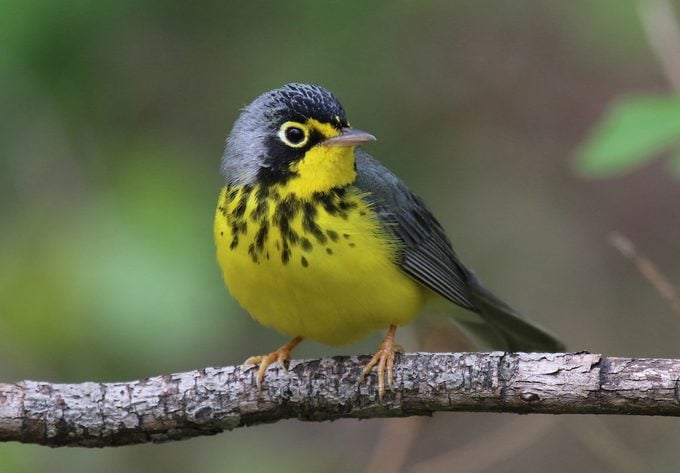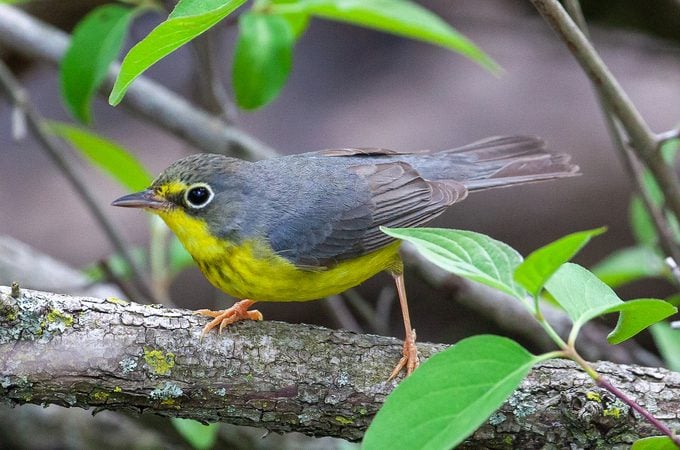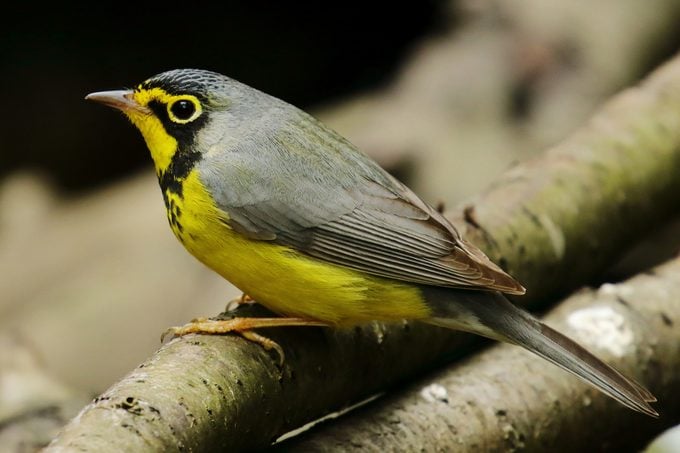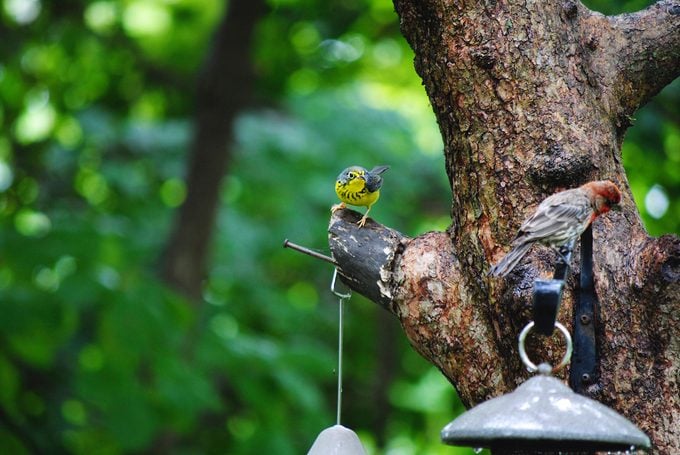Meet the Colorful Canada Warbler
Updated: Apr. 03, 2024
See what a Canada warbler looks like and where to find this species. Also, learn about their diet, songs and nesting habits.
On This Page
What Does a Canada Warbler Look Like?

Doug Hitchcox, staff naturalist with Maine Audubon, says, “Canada warblers are easily recognizable thanks to the fairly unique plumage of slate-blue above, yellow below, with a wide ring around the eye best described as ‘spectacles’ and a restricted black necklace across the chest. The magnolia warbler is superficially similar but has white markings on the wings, more black extending down the flanks for its necklace, and a patch of yellow on their rump (not to be confused with the yellow-rumped warbler).”
According to Doug, if you want to know if a Canada warbler is a male, female or juvenile, pay close attention to the vibrance of the bird’s plumage.

“Think of their plumage on a scale from brightest and boldest on one end to drab and unmarked on the other,” he says. “Adult males would be plotted closest to the bright and bold end thanks to the sharp contrasts in their markings. Adult females show similar field marks but toned down, especially lacking the dark facial markings and showing a muted black necklace. Younger birds continue down that scale, getting progressively duller but fortunately still retaining enough of the classic field marks to be easily recognizable.”
Learn how to identify a palm warbler.
Range and Habitat

Doug says, “Canada warblers are a classic boreal forest breeder with most of their summer range falling, appropriately, in Canada’s boreal forest, but extending south into northern states with appropriate habitat and along higher elevations of the Appalachian Mountains. In our winter, they are primarily in the Northern Andes, south to Peru.”
Breeding Bird Survey data shows Canada warbler population numbers are declining. Doug has a suggestion for how birders can help them. “This species can often be found in coffee plantations in its winter range, which is a good reminder that bird lovers should purchase shade-grown ‘bird friendly’ coffee to help protect the areas that these birds are using in the winter.”
If you want to spot these warblers, you need to know the habitat they prefer.
“These birds are often found near open water, probably because it provides much of the food (winged insects) that they are looking for,” Doug says. “They can be found in mixed forests, but need a dense understory if they want a place to nest.”

“I have never seen this pretty yellow bird before. I think it is a Canada warbler (above). Is this a rare sighting in my area?” asks Birds & Blooms reader Lisa Trimble of Delanco, New Jersey.
Birding experts Kenn and Kimberly Kaufman say, “Yes, this is a Canada warbler, probably a female or a young bird. Late August is well within the period of their fall migration, when Canada warblers leave their nesting grounds for their winter range in South America. Although this species is a regular migrant through your general area, it often hides in thickets or forest undergrowth, so it’s a rare treat to have one as a backyard visitor.”
Diet: What Do Canada Warblers Eat?
You’re unlikely to see this bird on your backyard sunflower seed feeder but it might visit your bird bath.
“Canada warblers are obligate insectivores, favoring flying insects like flies and mosquitoes. This is why they travel to the boreal forest in our summer,” says Doug. “It is rare for them to visit backyards, though a water feature would be more appealing than almost any bird food we would provide.”
He also emphasizes the importance of including native plants in our yards to support native insects that the birds feed on.
Learn more about what warblers eat and how to attract them.
Nesting Habits
As a surprise to many, Canada warblers typically build their nests on the ground. “They’ll find a spot on a slight slope, preferably with an overhang, where they’ll construct a small nest from woven plant matter. The female does most of the actual nest building, but the male does help collect materials,” Doug says.
This is not a species that mates for life. Doug explains, “While both parents have roles in raising the young, making them ‘socially monogamous,’ studies have shown that about half of all nests had genes from multiple males contributing.”
Learn how to identify an American redstart.
Canada Warbler Song
Bird songs courtesy of the Cornell Lab of Ornithology
“Canada warblers do have a distinctive song but it doesn’t have an easily memorizable gimmicky mnemonic like many of the other warblers,” Doug says. “The song is a rapid series of short bubbly notes, but the most unique part is the first note—a quick pop of noise that stands out a bit from the rest of the song. Remembering the first note as if the warbler stubbed its toe before shouting out a bubbly expletive is the best cue I can give for someone listening for this bird.”
About the Experts
Doug Hitchcox is the staff naturalist for Maine Audubon. He answers reader questions about birds and wildlife in the Maine Sunday Telegram/Portland Press Herald.
Kenn and Kimberly Kaufman are the official birding experts for Birds & Blooms. They are the creators of the Kaufman Field Guide series and they speak and lead birding trips all over the world.
Why Trust Us?
For nearly 30 years, Birds & Blooms, a Trusted Media Brand, has been inspiring readers to have a lifelong love of birding, gardening and nature. We are the #1 bird and garden magazine in North America and a trusted online resource for over 15 million outdoor enthusiasts annually. Our library of thousands of informative articles and how-tos has been written by trusted journalists and fact-checked by bird and garden experts for accuracy. In addition to our staff of experienced gardeners and bird-watchers, we hire individuals who have years of education and hands-on experience with birding, bird feeding, gardening, butterflies, bugs and more. Learn more about Birds & Blooms, our field editor program, and our submission guidelines.




















